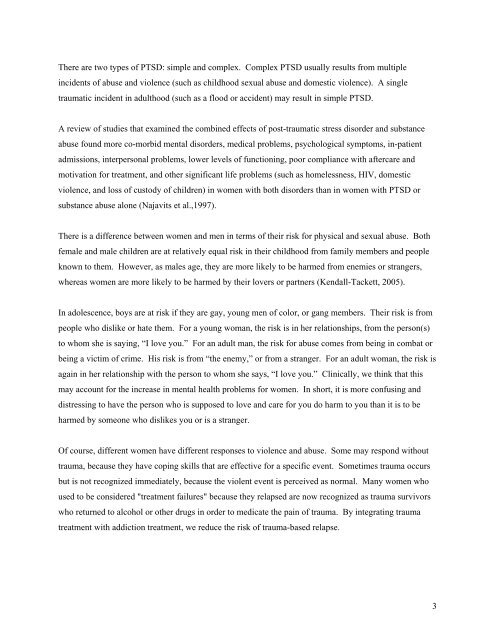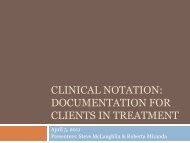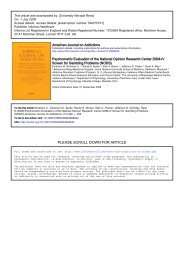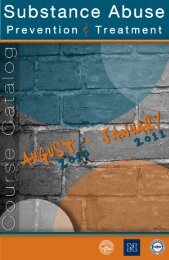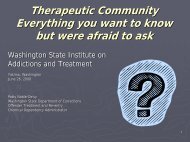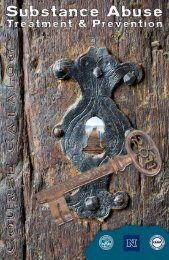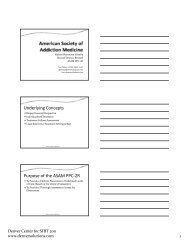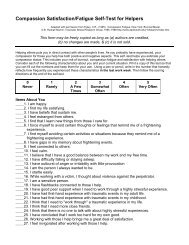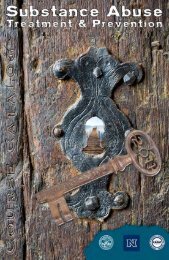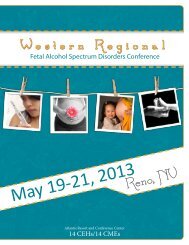Working with Substance Abusing Mothers: A Trauma ... - CASAT
Working with Substance Abusing Mothers: A Trauma ... - CASAT
Working with Substance Abusing Mothers: A Trauma ... - CASAT
Create successful ePaper yourself
Turn your PDF publications into a flip-book with our unique Google optimized e-Paper software.
There are two types of PTSD: simple and complex. Complex PTSD usually results from multiple<br />
incidents of abuse and violence (such as childhood sexual abuse and domestic violence). A single<br />
traumatic incident in adulthood (such as a flood or accident) may result in simple PTSD.<br />
A review of studies that examined the combined effects of post-traumatic stress disorder and substance<br />
abuse found more co-morbid mental disorders, medical problems, psychological symptoms, in-patient<br />
admissions, interpersonal problems, lower levels of functioning, poor compliance <strong>with</strong> aftercare and<br />
motivation for treatment, and other significant life problems (such as homelessness, HIV, domestic<br />
violence, and loss of custody of children) in women <strong>with</strong> both disorders than in women <strong>with</strong> PTSD or<br />
substance abuse alone (Najavits et al.,1997).<br />
There is a difference between women and men in terms of their risk for physical and sexual abuse. Both<br />
female and male children are at relatively equal risk in their childhood from family members and people<br />
known to them. However, as males age, they are more likely to be harmed from enemies or strangers,<br />
whereas women are more likely to be harmed by their lovers or partners (Kendall-Tackett, 2005).<br />
In adolescence, boys are at risk if they are gay, young men of color, or gang members. Their risk is from<br />
people who dislike or hate them. For a young woman, the risk is in her relationships, from the person(s)<br />
to whom she is saying, “I love you.” For an adult man, the risk for abuse comes from being in combat or<br />
being a victim of crime. His risk is from “the enemy,” or from a stranger. For an adult woman, the risk is<br />
again in her relationship <strong>with</strong> the person to whom she says, “I love you.” Clinically, we think that this<br />
may account for the increase in mental health problems for women. In short, it is more confusing and<br />
distressing to have the person who is supposed to love and care for you do harm to you than it is to be<br />
harmed by someone who dislikes you or is a stranger.<br />
Of course, different women have different responses to violence and abuse. Some may respond <strong>with</strong>out<br />
trauma, because they have coping skills that are effective for a specific event. Sometimes trauma occurs<br />
but is not recognized immediately, because the violent event is perceived as normal. Many women who<br />
used to be considered "treatment failures" because they relapsed are now recognized as trauma survivors<br />
who returned to alcohol or other drugs in order to medicate the pain of trauma. By integrating trauma<br />
treatment <strong>with</strong> addiction treatment, we reduce the risk of trauma-based relapse.<br />
3


